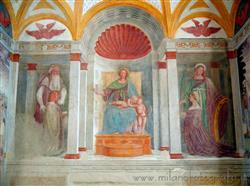|
Melzo (Milan, Italy): Church of Sant'Andrea
|
|
|
Show an other place around Milan worth a visit: |
 The Church of Sant'Andrea is a small church, but it is rich in art, history and even mysteries. The Church of Sant'Andrea is a small church, but it is rich in art, history and even mysteries.
Based on the archaeological findings which unearthed the primitive foundations, the construction of the church can be traced back to a period between the eleventh and thirteenth centuries. It was built as a private church, although occasionally also accessible to all the inhabitants of the village.
Originally its structure included a semicircular apse and a rectangular nave.
At the end of the thirteenth century it was enlarged and updated to the at that time new Lombard Gothic style. The apse became square and the nave came to be constituted by four spans, covered with a ceiling supported by arches with an acute angle.
The church reached its peak in the second half of the fifteenth century, the time of the Sforza, the time when the frescoes in the presbytery were painted.
In the seventeenth century it became the seat of a confraternity and in the eighteenth century baroque side chapels were added, in correspondence of one of which a side entrance was then created (Fig. 4).
Already in the nineteenth century its frescoes had been forgotten, hidden by layers of plaster, so that the building was used as a hospital for cholera patients and to accommodate soldiers during times of war.
In 1922 the church was sold to a private and was used as a warehouse. In the 60s of the last century it even risked to be torn down!
Its revival began in 1968, when it was donated to the parish priest of Melzo.
Various restoration works, promoted among other by the to this special purpose founded Association of the Friends of Sant'Andrea, have since then allowed to bring back the former glory of the church frescoes, as well to collect some interesting finds. Investigations have in fact led to propose suggestive theories about the history of the church.
Since about 1990, the church, which was not consecrated again, is normally used for both church services and weddings, for classical music concerts and for predominantly religious exhibitions/exposures.
As regards the outside, it is very simple, with the central part with exposed brickwalls and the lateral parts with plastered walls. There are no decorations worthy of note. There is a fairly high bell tower in the back left.
The apse frescoes contain references to the assassination of Galeazzo Maria Sforza and seem to have been commissioned by his daughter Caterina Sforza to artists close to Leonardo da Vinci when she met the great master in 1487, on the occasion of the tenth anniversary of the assassination of her father.
First, on the wall of the apse the clients are represented alongside their protectors: Caterina Sforza, with Saint Catherine from Alexandria, and her husband Girolamo Riario, with St. Jerome.
They are portrayed in the act of begging the Virgin, represented together with Jesus Child and with St. John, to intercede to grant forgiveness to the sinner guilty of the crime.
The representation of the martyrdom of Saint Andrew on the left wall would then be a direct reference to the killer of Galeazzo Maria Sforza, Gio 'Andrea' from Lampugnano, and to his punishment for the crime he had committed.
Authors of the frescoes would be Bernardino Zenale and the members of his workshop.
The fact, however, that the fresco of the martyrdom of Saint Andrew contains brushstrokes done both with his right hand and with the left hand and considering the fact that among the artists close to Leonardo nobody was ambidextrous, unless the Master himself, has led some to hazard the hypothesis that this fresco is, at least in part, a work of Leonardo da Vinci himself!
A further indication in favor of the involvement of Leonardo da Vinci in the history of the Church of Sant'Andrea would be also the particular geometric figures etched into the base of the arch of the apse and present in various writings of Leonardo da Vinci (one of the two figures is visible in Fig. 2).
It should, however, also be said that according to a recent research, by contrast, the frescoes in the apse would date back partly to 1524 (by Nicola Mangone said Moietta) and partly to 1573-74 by Ottavio Semino. It was Professor Giovanni Agosti in his book on Mantegna the first expert to attribute the painting to the art of Moietta. Professor Giulio Bora, well-known expert of the Lombard painting of the sixteenth century, together with historians Federico Cavalieri and Stefano Bruzzese, authoritatively confirm and support these attributions. See also, for a wide discussion (only Italian): CENTRO STUDI GUGLIELMO GENTILI MELZO - GLI AFFRESCHI DELL’ABSIDE DELLA CHIESA DI SANT’ANDREA DI MELZO.
We must also mention the skull that was found under the apse during renovation works. Several clues suggest that it may belong to Galeazzo Maria Sforza.
Categories: Places of historical value of artistic value
via Sant'Andrea 3, Melzo |
Further pictures of Church of Sant'Andrea in the section Photography |